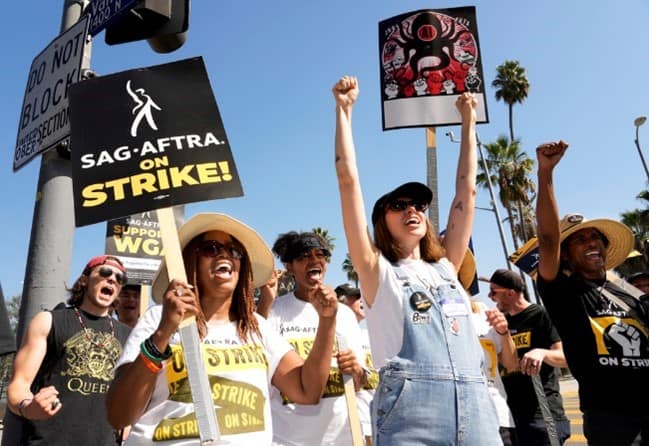By Andrew Jenck
After 146 days, the writer’s strike finally ended on September 27, as studios and the Writer’s Guild of America (WGA) came to a tentative agreement; concerning writer’s pay, employment, residuals, and protections against AI. Such a resolution comes after on and off negotiations and studios employing questionable strategies. Before the establishment of the current terms, a summary of proposals was released by the studios intended to divide union members, only to receive backlash for their half measures. As writers resume work, however, the Screen Actors Guild – American Federation of Television and Radio Artists (SAG-AFTRA) only just received a fair deal on November 8, over a month later. Barriers reflected the writers’ demands: lack of fair residuals for streaming content and threat of being replaced with AI digital scanning. Despite being the first simultaneous pair of such strikes since 1960, studios were stubborn in granting fair deals, failing to understand the value of actors at all stages and relying on actors’ financial instability to prevent urgency.
It’s important to acknowledge that while A-List celebrities such as Tom Cruise and Jennifer Lawrence are union members, they’re a small fraction of SAG-AFTRA. Most members are cast in minor roles, the likes of cameos, speak few lines of dialogue, or appear in the background. Acting is gig based; hence many will go months without landing a role in the competitive Hollywood industry; think of the audition scenes from La La Land. For executive producers, it’s easy to dismiss these employees due to their limited screentime, but failing to provide sufficient pay would prevent future stars rising. Many Oscar and Emmy-winners have expressed their struggles at the start of their careers, living off residuals between roles. Most infamously, the cast of Oppenheimer left the world premier right when the strike began, voicing their own experiences.
Once again, artificial intelligence was a source of contention: studios’ original proposal was to offer a day’s pay to background actors for a digital scan and ensure eternal ownership of said actors’ likeness. No further permission would’ve been required for future use. This could’ve prevented future opportunities as they would essentially be assets owned by one studio, potentially preventing competing studios from working with those actors or their likenesses. Nearly all A-Listers started their career in the background. One of Matt Damon’s and Ben Affleck’s first roles were attendees at Fenway Park in Field of Dreams. Octavia Spencer had two lines in Spider-Man. Had these actors been forced to sell their likeness, they may not have landed their starring roles, and studios wouldn’t have utilized their talents. One of the last barriers that prevented a tentative deal was the ability to utilize AI likeness of deceased actors without permission of their estates.
These strikes have their consequences: California’s economy was hurt and nonunion members such as makeup artists and camera operators were out of work. However, strikes are purposefully disruptive, a last resort to call attention to issues hurting the industry. The original proposals would’ve hurt the studios in the long-term, preventing any upward trajectory and stability for new actors living in some of the most expensive areas in the US. CEOs are historically stubborn, as seen in strikes of the past. In 1960, actors went on strike for lack of residuals for films airing on television. Residuals for home releases and cable television again took center stage at the 1989 strike. Producers underestimate their employees’ resilience, as even without pay, the unions are well organized, led by longtime actors who know how reliant Hollywood is on consistent content.
Needing to salvage their 2024 release calendar, studios caved, having to air reruns on TV and delaying finished films such as Dune: Part Two, and halting production of Deadpool 3 and Mission: Impossible. The new deal, according to SAG-AFTRA, is valued at $1 billion, including increased pay and compensation, protections of diverse communities, and required consent for AI. Such victories come at a price, literally, as streaming services raised subscription fees, and employees are concerned over cutting costs elsewhere. However, the new terms do not even decrease profits by half of a percent. The entertainment industry is volatile, requiring a lot of risk management, and then there are this year’s disappointing box office returns. However, cutting the payroll is not the solution; it’s shortsighted. The past months reveal the mindset of corporate America where a strategy of immediate profit can negate any potential revenue. Producers will have another deal with the Animation Guild next summer, and should they refuse cooperation, then nothing will be learned.


